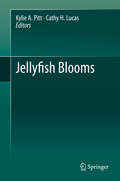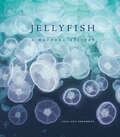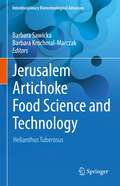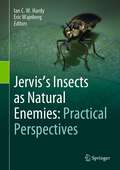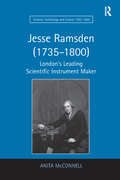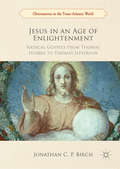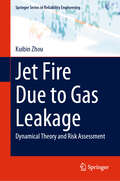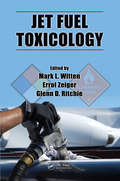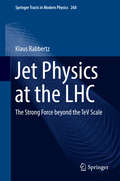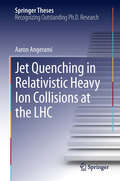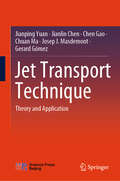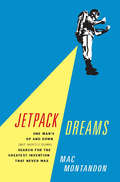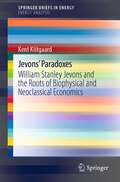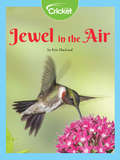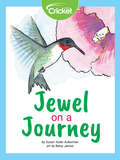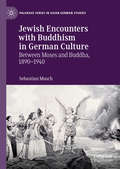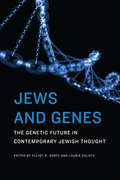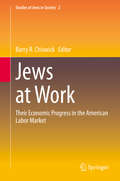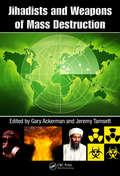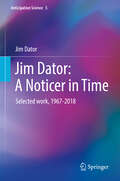- Table View
- List View
Jellyfish Blooms
by Kylie A. Pitt Cathy H. LucasJellyfish are one of the most conspicuous animals in our oceans and are renowned for their propensity to form spectacular blooms. The unique features of the biology and ecology of jellyfish that enable them to bloom also make them successful invasive species and, in a few places around the world, jellyfish have become problematic. As man increasingly populates the world's coastlines, interactions between humans and jellyfish are rising, often to the detriment of coastal-based industries such as tourism, fishing and power generation. However we must not lose sight of the fact that jellyfish have been forming blooms in the oceans for at least 500 million years, and are an essential component of normal, healthy ocean ecosystems. Here many of the world's leading jellyfish experts explore the science behind jellyfish blooms. We examine the unique features of jellyfish biology and ecology that cause populations to 'bloom and bust', and, using case studies, we show why jellyfish are important to coastal and ocean ecosystem function. We outline strategies coastal managers can use to mitigate the effects of blooms on coastal industries thereby enabling humans to coexist with these fascinating creatures. Finally we highlight how jellyfish benefit society; providing us with food and one of the most biomedically-important compounds discovered in the 20th century.
Jellyfish and Other Stingers (World Book's Animals of the World)
by Joseph K. BrennanThis book answers many questions about jellyfish. Did you know that there is a jellyfish that spends its whole life upsidedown? Other books in this series are available from Bookshare.
Jellyfish: A Natural History
by Lisa-ann GershwinAn introduction to these bizarre and beautiful creatures of the sea, filled with color photos and illustrations: &“Fascinating.&”—Boing Boing Jellyfish are the oldest multi-organed life form on the planet, having inhabited the ocean for more than five hundred million years. With their undulating umbrella-shaped bells and sprawling tentacles, they are compelling and gorgeous, strange and dangerous. In many places they&’re also vastly increasing in number, and these population blooms may be an ominous indicator of the rising temperatures and toxicity of the oceans.Jellyfish presents these aquarium favorites in all their glory. Fifty unique species, from the purple people eater to black sea nettles, are presented in stunning photos along with the most current scientific information on their anatomy, history, distribution, position in the water, and environmental status. Foremost jellyfish expert Lisa-ann Gershwin provides an insightful look at the natural history and biology of each of these spellbinding creatures, plus a timely take on their place in the rapidly changing and deteriorating condition of the oceans. Learn about immortal jellyfish who live and die and live again—as well as those who camouflage themselves amid sea grasses and shells, hiding in plain sight. Discover the jellyfish that&’s the world&’s most venomous animal, and the jellyfish that helped scientists win the Nobel Prize. They&’re all here and more in this delightful volume. &“A thorough coverage of jellyfish history, biology and ecology. Gershwin, a marine biologist who has discovered over 200 new species of jellyfish, does an excellent job of combining a compelling narrative of 50 different jellyfish with luscious, I-can&’t-believe-they&’re-real photos.&”—Boing Boing
Jerome Lemelson: The Man Behind Industrial Robots (Little Inventor)
by Lucia RaatmaWhy is Jerome Lemelson important? His inventions helped create industrial robots, cassette players, and more! Readers follow his journey from struggling inventor to a multimillionaire with more than 600 patents. This story of determination is filled with engaging text and colorful images, all reviewed by Smithsonian experts.
Jerusalem Artichoke Food Science and Technology: Helianthus Tuberosus (Interdisciplinary Biotechnological Advances)
by Barbara Sawicka Barbara Krochmal-MarczakThis is the first book to explore the science underlying the Jerusalem artichoke, which is also known as Helianthus tuberosus L. and it is attracting increasing interest among food scientists and professionals worldwide. Due to a wide perspective for the production of inulin due to its high economic and ecological importance, the development of technologies for isolating and processing tuberous sunflower raw materials using environmentally friendly technologies (green chemistry and white biotechnology) and the global production of inulin shows an increasing tendency. Here we focus on the latest technological achievements related to the use of inulin in the food processing. In this book, readers will find full explanation of the conceptual aspects and the latest research results on a wide range of topics, including the relevant characteristics and applications from various fields. Written by leading scientists in the field, the book will be a valuable resource for students and researchers in the fields of food chemistry, nutritional science, physiology, and bioengineers, as well as for professionals in the food industry.
Jervis's Insects as Natural Enemies: Practical Perspectives
by Ian C.W. Hardy Eric WajnbergThere has been a dramatic increase in theoretical and practical studies on insect natural enemies over the last decades. The appeal of insect predators and, in particular, parasitoids, as research animals derives from the relative ease with which many species may be cultured and experimented on in the laboratory, the simple life-cycles of most parasitoid species, and the increasing demand for biological pest control as a key component of the integrated pest management approach.There is now a very substantial literature on insect natural enemies and thus a great need for a general text that enquiring students or research workers can use in deciding on approaches and techniques that are appropriate to the study and evaluation of such insects. This book fulfils that demand. It is a considerably updated and expanded version of a previous best-seller and provides an account of major aspects of the biology of predators and parasitoids, punctuated with information and advice on which experiments or observations to conduct and, importantly, how to carry them out. Guidance is provided, where necessary, on the most recent further literature that may need to be consulted on given topics.While researchers can now refer to several books on parasitoids and predators, Jervis’s Insects as Natural Enemies is unique in emphasising practicalities. It is aimed at students and professionals working in universities and both government and commercial institutes in the fields of integrated pest management, agriculture, horticulture and forestry, as well as those interested in fundamentals of behavioural, population, community and evolutionary ecology.
Jess & Layla's Astronomical Assignment
by Lucy CourtenayJess and Layla travel back in time to understand Astronomy.
Jesse Ramsden: London's Leading Scientific Instrument Maker (Science, Technology and Culture, 1700-1945)
by Anita McConnellJesse Ramsden was one of the most prominent manufacturers of scientific instruments in the latter half of the eighteenth century. To own a Ramsden instrument, be it one of his great theodolites or one of the many sextants and barometers produced at his London workshop, was to own not only an instrument of incredible accuracy and great practical use, but also a thing of beauty. In this, the first biography of Jesse Ramsden, Dr Anita McConnell reconstructs his life and career and presents us with a detailed account of the instrument trade in this period. By studying the life of one prominent instrument maker, the entire practice of the trade is illuminated, from the initial commission, the intricate planning and design, through the practicalities of production, delivery and, crucially, payment for the work. The book will naturally be of immeasurable interest to historians of science and scientific instruments but, as it also sheds light on the increasing commercialisation of the scientific trade on the cusp of the Industrial Revolution, should also interest social and economic historians of the eighteenth century.
Jesus in an Age of Enlightenment: Radical Gospels from Thomas Hobbes to Thomas Jefferson (Christianities in the Trans-Atlantic World)
by Jonathan C. BirchThis book explores the religious concerns of Enlightenment thinkers from Thomas Hobbes to Thomas Jefferson. Using an innovative method, the study illuminates the intellectual history of the age through interpretations of Jesus between c.1750 and c.1826. The book demonstrates the persistence of theology in modern philosophy and the projects of social reform and amelioration associated with the Enlightenment. At the core of many of these projects was a robust moral-theological realism, sometimes manifest in a natural law ethic, but always associated with Jesus and a commitment to the sovereign goodness of God. This ethical orientation in Enlightenment discourse is found in a range of different metaphysical and political identities (dualist and monist; progressive and radical) which intersect with earlier ‘heretical’ tendencies in Christian thought (Arianism, Pelagianism, and Marcionism). This intellectual matrix helped to produce the discourses of irenic toleration which are a legacy of the Enlightenment at its best.
Jet Age: The Comet, the 707, and the Race to Shrink the World
by Sam Howe VerhovekThe book is the captivating story of the titans, engineers, and pilots who raced to design a safe and lucrative passenger jet.
Jet Fire Due to Gas Leakage: Dynamical Theory and Risk Assessment (Springer Series in Reliability Engineering)
by Kuibin ZhouThis book presents a theoretical framework for the quantitative calculation of casualties and damage from jet fires caused by high-pressure gas leaks in pressure vessels or pipelines. The framework incorporates gas leakage models, combustion dynamics models, thermal radiation models, and thermal damage criteria. It conducts sensitivity and uncertainty analyses for the input parameters of the theoretical framework. The robustness of the theoretical framework is verified through field tests. Ultimately, the theoretical framework is used to quantitatively analyze the accidents involving jet fires due to the rupture of natural gas transmission pipelines. The sub-models within the theoretical framework are developed using the fundamental principles of thermodynamics, combustion, fluid dynamics, and heat transfer, and have been validated by small-scale laboratory tests. However, the theoretical framework receives the validation of field tests and real-world case studies. The theoretical deductions in this book offer significant guidance for scaling up from the laboratory experiments to field applications. The book is intended for anyone interested in understanding the risks associated with gas leaks and jet fires. The methodology enables the calculation of hazards for specific processes in isolation or their integration to assess overall consequences.
Jet Fuel Toxicology
by Mark L. Witten Errol Zeiger Glenn D. RitchieCurrently serving as a resource for the National Center for Toxological Research in their work with the Gulf Coast oil spill, this book presents current research conducted primarily by the airforce on the toxic effects of JP-8 jet fuel on the pulmonary, immune, dermal, and nervous systems. In all, the book considers 13 toxicology studies
Jet Physics at the LHC
by Klaus RabbertzThis book reviews the latest experimental results on jet physics from proton-proton collisons at the LHC. Jets allow to determine the strong coupling constant over a wide range of energies up the highest ones possible so far, and to constrain the gluon parton distribution of the proton, both of which are important uncertainties on theory predictions in general and for the Higgs boson in particular. A novel approach in this book is to categorize the examined quantities according to the types of absolute, ratio, or shape measurements and to explain in detail the advantages and differences. Including numerous illustrations and tables the physics message and impact of each observable is clearly elaborated.
Jet Quenching in Relativistic Heavy Ion Collisions at the LHC
by Aaron AngeramiThis thesis presents the first measurements of jets in relativistic heavy ion collisions as reported by the ATLAS Collaboration. These include the first direct observation of jet quenching through the observation of a centrality-dependent dijet asymmetry. Also, a series of jet suppression measurements are presented, which provide quantitative constraints on theoretical models of jet quenching. These results follow a detailed introduction to heavy ion physics with emphasis on the phenomenon of jet quenching and a comprehensive description of the ATLAS detector and its capabilities with regard to performing these measurements.
Jet Transport Technique: Theory and Application
by Gerard Gómez Josep J. Masdemont Chen Gao Jianlin Chen Jianping Yuan Chuan MaThis book focuses on the Jet Transport (JT) technique and gives a systematic introduction on its theory development, algorithm implementation, and in particular, the applications in the field of astronautics including uncertainty propagation, filtering, as well as guidance and control. It features on the combination of mathematical theory and engineering applications, making the technique to be understood and mastered straightforwardly. Moreover, the JT-based methods proposed in the book offer a new and ingenious way to some classical problems. Given its breadth of coverage, the book offers a valuable reference guide for researchers and engineers interested in the JT methodology including theory and applications.
Jetpack Attack (Carmen Sandiego Chase-Your-Own Capers)
by Houghton Mifflin HarcourtJoin Carmen Sandiego and decide where in the world to go next in this globe-trotting, daring caper! Stop VILE from stealing the superior jetpack technology you&’ve developed and using it for nefarious deeds. With twenty possible endings, your adventures can take you all over the world—or out of the game. Which will you choose? In this choose-your-own-caper set in the world of Carmen Sandiego, you are unwittingly working as a technician developing a highly maneuverable jetpack for VILE. The prototype is almost complete when Carmen sneaks into your lab to steal it. That&’s when she tells you about VILE and their dastardly deeds. You decide to help Carmen try to keep this cutting-edge technology away from anyone who&’d use it as the ultimate thieving tool. Or do you? Twenty different possible endings keep readers coming back for more adventures with Carmen Sandiego!
Jetpack Dreams: One Man's Up and Down (But Mostly Down) Search for the Greatest Invention That Never Was
by Mac Montandon"Jetpack Dreams" chronicles the colorful pop history and science of that most amazing and mysterious of machines: the jetpack.<P><P> Fueled by a fascination and lifelong obsession with the power of flight, journalist Mac Montandon goes on a vastly entertaining search of the elusive invention. He examines the jetpackOCOs inspiration from the first shoulder-mounted wings to Bill SuitorOCOs 1984 Olympic flight, even uncovering a gruesome jetpack-related murder in Houston. From the earliest days of the OCOpack to its enduring role in popular culture?with Buck Rogers, James Bond, Boba Fett?Montandon seeks to answer two simple questions: Where is the jetpack that was promised to him, and to all of us, years ago? And if itOCOs out there, can he catch a ride?"
Jevons' Paradoxes: William Stanley Jevons and the Roots of Biophysical and Neoclassical Economics (SpringerBriefs in Energy)
by Kent KlitgaardIn 1865, economist William Stanley Jevons published The Coal Question, describing the crucial role that coal played in British economic development. Here, he enunciated what has come to be known as the Jevons paradox, which stated that improvements in resource efficiency leads to greater resource use as the expansion of scale occasioned by lower operating costs overwhelms the savings due to greater efficiency. The implications for any sustainability scenario are enormous and a major theme of this book. While The Coal Question provided the theory that was a precursor to peak oil and resource limits to growth, it was followed six years later by the Theory of Political Economy, the first English-language work of neoclassical economics, which denies the importance of energy as a special commodity. In spite of this apparent contradiction, in this book biophysical economist Kent Klitgaard makes clear that there is no epistemological break between The Coal Question and Theory of Political Economy. Indeed, the Jevons paradox makes little sense in the absence of a behavioral theory grounded in marginal utility, which recognizes the satisfaction that each of us gains as consumers of one more unit of a good or service. Jevons could not solve this paradox in light of his belief that coal mines were becoming exhausted and more expensive to operate, and that there was no substitute for coal. However, he was uninterested in questions of sustainability; rather, he wanted to maintain British industrial and imperial dominance. Did the eventual substitution of oil for coal simply allow us to run through other resources at an accelerated rate? Indeed, the petroleum economy of the 20th and early 21st centuries has presented vastly expanded opportunities for the operation of the Jevons Paradox. This book shows the connections among the different paradoxes in Jevons’ work, and exposes the potentially fatal flaws that confound technological solutions to the sustainability challenge.
Jewel in the Air
by Kris MacLeodAlmost as light as a penny and with wings beating more than fifty times each second, these tiny Central American hummingbirds migrate 2,000 miles to reach their spring home. Readers will enjoy learning about the ruby-throated hummingbird along with a retelling of Mayan tale.
Jewel on a Journey
by Betsy James Susan Yoder AckermanTrey and Susannah hear a loud thump and learn that the fallen tiny bird laying on their deck is a Hummingbird! Miss Nora, their neighbor, cares for birds and may be able to help them save the bird. Discover what Miss Nora does to help the Hummingbird. Will the injured bird fly again?
Jewish Encounters with Buddhism in German Culture: Between Moses and Buddha, 1890–1940 (Palgrave Series in Asian German Studies)
by Sebastian MuschIn Germany at the turn of the century, Buddhism transformed from an obscure topic, of interest to only a few misfit scholars, into a cultural phenomenon. Many of the foremost authors of the period were profoundly influenced by this rapid rise of Buddhism—among them, some of the best-known names in the German-Jewish canon. Sebastian Musch excavates this neglected dimension of German-Jewish identity, drawing on philosophical treatises, novels, essays, diaries, and letters to trace the history of Jewish-Buddhist encounters up to the start of the Second World War. Franz Rosenzweig, Martin Buber, Leo Baeck, Theodor Lessing, Jakob Wassermann, Walter Hasenclever, and Lion Feuchtwanger are featured alongside other, lesser known figures like Paul Cohen-Portheim and Walter Tausk. As Musch shows, when these thinkers wrote about Buddhism, they were also negotiating their own Jewishness.
Jews and Genes: The Genetic Future in Contemporary Jewish Thought
by Rabbi Elliot N. Dorff Dr Laurie ZolothWell aware of Jews having once been the victims of Nazi eugenics policies, many Jews today have an ambivalent attitude toward new genetics and are understandably wary of genetic forms of identity and intervention. At the same time, the Jewish tradition is strongly committed to medical research designed to prevent or cure diseases. Jews and Genes explores this tension against the backdrop of various important developments in genetics and bioethics—new advances in stem cell research; genetic mapping, identity, testing, and intervention; and the role of religion and ethics in shaping public policy. Jews and Genes brings together leaders in their fields, from all walks of Judaism, to explore these most timely and intriguing topics—the intricacies of the genetic code and the wonders of life, along with cutting-edge science and the ethical issues it raises.
Jews at Work: Their Economic Progress in the American Labor Market (Studies of Jews in Society #2)
by Barry R. ChiswickThis book addresses the educational, occupational, and income progress of Jews in the American labor market. Using theoretical and statistical findings, it compares the experience of American Jews with that of other Americans, from the middle of the 19th century through the 20th and into the early 21st century.Jews in the United States have been remarkably successful; from peddlers and low-skilled factory workers, clearly near the bottom of the economic ladder, they have, as a community, risen to the top of the economic ladder. The papers included in this volume, all authored or co-authored by Barry Chiswick, address such issues as the English language proficiency, occupational attainment and earnings of Jews, educational and labor market discrimination against Jews, life cycle and labor force participation patterns of Jewish women, and historical and methodological issues, among many others. The final chapter analyzes alternative explanations for the consistently high level of educational and economic achievement of American Jewry over the past century and a half. The chapters in this book also develop and demonstrate the usefulness of alternative techniques for identifying Jews in US Census and survey data where neither religion nor Jewish ethnicity is explicitly identified. This methodology is also applicable to the study of other minority groups in the US and in other countries.
Jihadists and Weapons of Mass Destruction
by Gary Ackerman Jeremy TamsettExplores the Nexus Formed When Malevolent Actors Access Malignant MeansWritten for professionals, academics, and policymakers working at the forefront of counterterrorism efforts, Jihadists and Weapons of Mass Destruction is an authoritative and comprehensive work addressing the threat of weapons of mass destruction (WMD) in the hands of jihadists,
Jim Dator: Selected work, 1967-2018 (Anticipation Science #5)
by Jim DatorThis book features a selection of the published writings and public presentations of Jim Dator. Most of the chapters are directly concerned with futures studies and ideas about the futures. The topic covers many disciplines and subjects. It is also concerned with many different parts of the world, even Mars. In addition, a few of the earlier papers contained here are about more conventional topics in politics and religion.The collection spans a more than 50 year period of thought, reflection, and instruction. In particular, the papers examine six main topics. These include meditations on the very nature of future studies, visions of preferred futures, ideas about alternative futures, and details on future theories and methods. Coverage also considers such specific topics as AI and robots, the environment, food, culture, energy, families, future generations, and more.Overall, these papers help readers gain insight into what it takes to weave together alternative images of the future in useful ways. They also reveal cross-disciplinary patterns in key fields of human endeavor that will help readers better understand trends and emerging issues.
